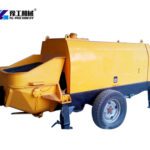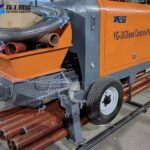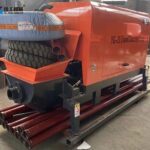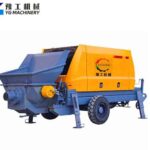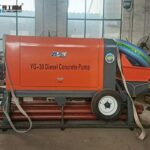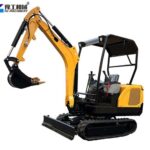Mini concrete pump machine is a compact, highly mobile piece of construction equipment designed to continuously transfer freshly mixed liquid concrete from a mixer or hopper to the exact placement point, often in areas inaccessible to standard concrete trucks or boom pumps. Its primary function is to eliminate the backbreaking manual labor of moving concrete via wheelbarrows or buckets, dramatically increasing the speed, quality, and overall cost-efficiency of concrete pouring operations. These pumps are an indispensable tool for a wide range of projects, from small residential foundations and backyard slabs to complex urban renovations, tunnel linings, and so on.
Parts of a Mini Concrete Pump
To appreciate its capabilities, one must first understand its composition. A mini concrete pump is a symphony of mechanical and hydraulic components working in perfect harmony.
- The Chassis and Frame: This is the skeletal structure, typically a robust, wheel-mounted trailer. It provides portability and houses all other components.
- The Power Source: The heart that drives the machine. Most mini pumps are powered by dependable diesel engines for ultimate job-site independence or electric motors for quiet, fume-free operation in enclosed spaces.
- The Hydraulic System: The circulatory system. It consists of a hydraulic pump, valves, cylinders, and oil tanks. This system generates the immense, controlled force required for the pumping action.
- The Concrete Hopper: The mouth of the machine. This is where the ready-mix concrete is fed. It is equipped with an agitator or mixing blades that continuously stir the concrete, preventing segregation and ensuring a consistent, pumpable mix.
- The S-Valve and Cylinders: The brain of the operation. Two hydraulic cylinders work in tandem. While one cylinder retracts, drawing concrete from the hopper into its material cylinder, the other extends, pushing the concrete from its cylinder out through the S-Valve and into the delivery pipeline. The S-Valve, a critical wear-resistant component, oscillates to switch between the two cylinders, creating a continuous, pulsation-dampened flow of concrete.
- The Delivery System: The arms and legs. This comprises high-pressure, flexible or rigid steel pipelines and hoses that carry the concrete to its final destination. The end of the line is often fitted with a flexible hose for precise placement.
Applications Where The Mini Pump Shines
1. Residential and Small Scale Projects
It is perfect for pouring foundations, sidewalks, driveways, patios, pool shells, and retaining walls, especially when the access path to the backyard or basement is narrow.
2. Urban and Confined Sites
Mini pumps can be set up in a fraction of the space required for larger equipment, allowing work to proceed without major traffic disruption or the need for extensive site clearance. They are essential for basement construction, underground utility work, and high density housing projects.
3. Infrastructure and Repair
They are highly valued for repair work on bridges, tunnels, and elevated structures where only a small volume of concrete is needed at height or deep underground. Their ability to reach remote parts of a structure makes repair and maintenance more efficient.
Maintenance and Troubleshooting
Proper maintenance ensures long-term performance and safety. Here are some essential maintenance tips:
- Daily Cleaning: Clean the hopper, S-valve, and pipelines after each use to prevent concrete hardening.
- Lubrication: Regularly apply grease to key moving parts such as the pistons and valve systems.
- Check Hydraulic Oil Levels: Maintain adequate oil levels and replace oil periodically to ensure smooth operation.
- Inspect Wear Parts: Examine seals, hoses, and pipes for cracks or wear, and replace when necessary.
- Electrical and Control System Inspection: Regularly test safety switches and control panels for responsiveness.
- Seasonal Maintenance: In cold weather, ensure proper insulation and antifreeze measures for hydraulic systems.

